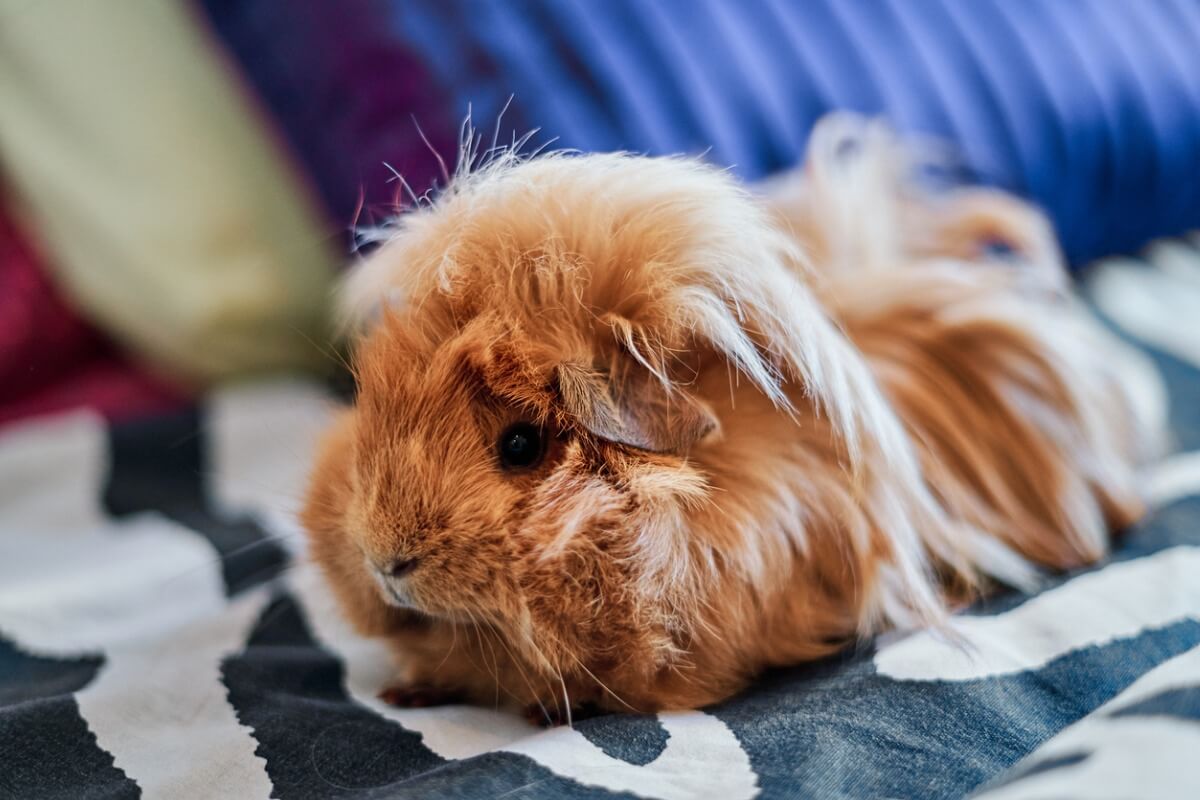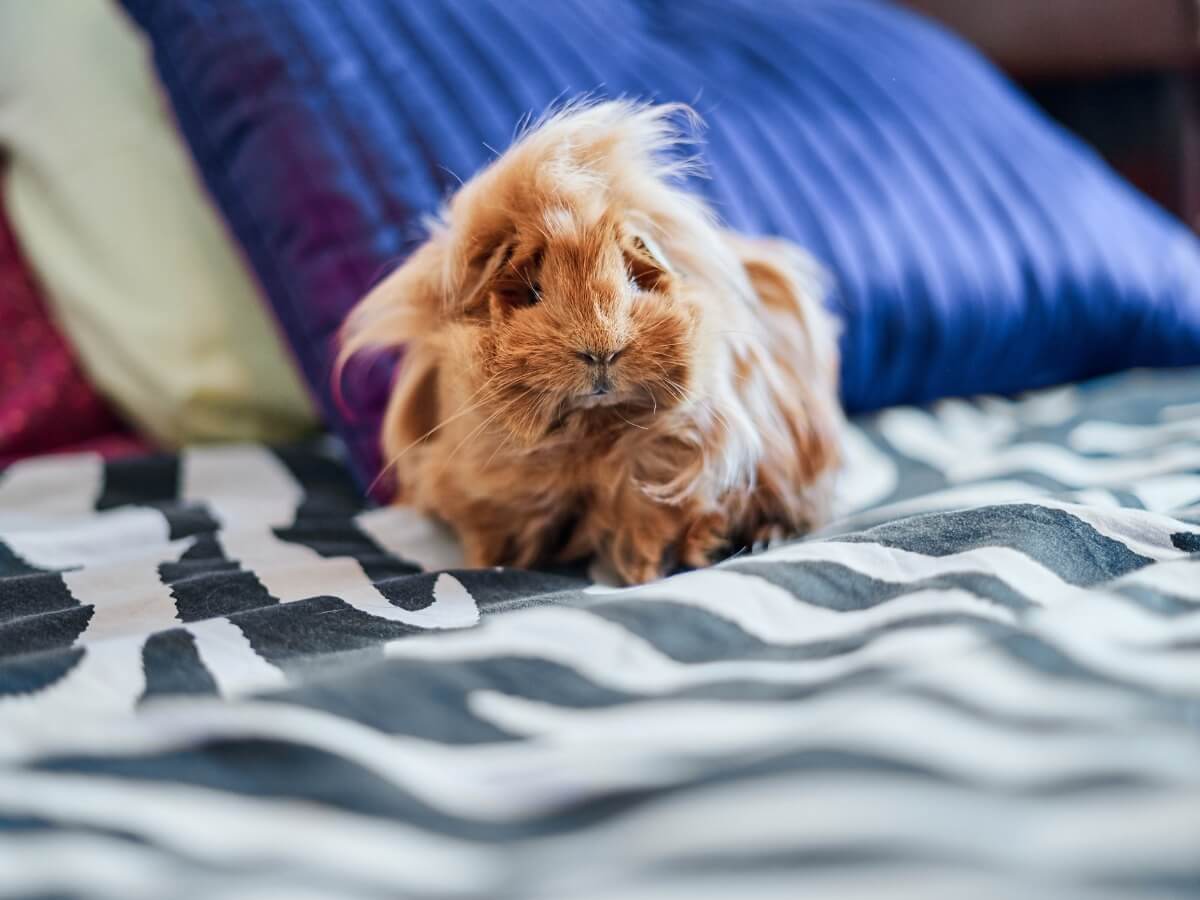Coronet Guinea Pig: Characteristics and Care


Written and verified by the biologist Cesar Paul Gonzalez Gonzalez
The coronet guinea pig is a rodent that has become famous as a pet due to its charismatic and furry appearance. This little guy loves to live with its owners and others of its kind. It’s an excellent companion because of its small size and gentle nature, although it needs good care to maintain its silky coat.
The coronet breed is the result of crossbreeding between crested guinea pigs and shelties. This is the reason why it has such a long coat and a small crest on its head. Looking after this rodent is simple, but requires a lot of attention. Read on to learn more about this beautiful animal.
The origin of the coronet guinea pig
The coronet guinea pig was first bred during the 1970s in England. This breed originated as a hybrid product of a cross between a crested guinea pig and a sheltie, from which it obtained its characteristic long-crested coat. At the end of this same decade, it arrived in the United States, where it acquired the appearance and coloration that we know today.
Description of the breed
Guinea pigs are fairly small, and range between 25 and 35 centimeters (10 to 14 inches) in length. Its hair falls from its back and curves at the tip, and is a type of large “veil” that covers its entire body. At the tip of its head, there are some shorter hairs that break with the general appearance. This is called the “crown” and is why it gets its name.
The coloration of its coat is very diverse. The most common tones are brown and white patterns, and the crown stands out for its contrasting colors. There are also darker colors such as black, gray, beige, or a combination of the above. It’s also possible to see the satin variety, which has a much shinier coat.

Personality
Guinea pigs, in general, are very sociable animals that love to attract their owner’s attention. They’re quite affectionate, playful, and energetic, so they need to be in constant motion to achieve peace of mind. When they don’t get what they need, they use their characteristic squeal.
Coronet guinea pig care
Regarding their care, the first point to consider is their hair, as this rodent needs a good brushing to prevent knots from forming on its body. For this purpose, use a brush with soft bristles and slow movements. At certain times, the coat should be trimmed, but only to prevent it from picking up too much dirt on the floor.
The coronet guinea pig is very hygienic and doesn’t need frequent bathing.
Habitat
The guinea pig’s home should be at least 1 square meter (just over 10 sq feet) in size. This is usually achieved with a rectangular container 130 centimeters long by 75 centimeters wide (4.2 by 2.4 feet). It may seem like a lot, but the extra space is something your pet will thank you for.
The temperature of its habitat should be kept between 10 and 25 degrees Celsius (50 to 77 F). This should be well monitored, as too much cold or heat can have serious repercussions on their health. In addition, you should let them out for frequent “walks” so it gets a change of scenery. This will help it to cool down if needed, while allowing it to explore and interact with its owner.
The floor of its habitat should be covered with absorbent substrate, such as paper or corn pellets. Both are excellent for containing odors and keeping the pet clean. Of course, you will have to be attentive to change it every time you need to in order to avoid the accumulation of dirt.
Avoid sawdust and wood substrates at all costs, as dust can cause respiratory problems for guinea pigs.
Ideal companions
Keep in mind that this rodent loves company, and so it’s good to keep 2 or more coronet guinea pigs together. Remember that, if you decide to do so, you’ll have to add 2 square meters (just over 20 square feet) to their habitat for each new specimen you have. You can mix males and females, although it’s preferable to have individuals of the same sex to avoid problems.
Coronet guinea pigs are herbivores and will eat almost any green food. However, they need a balanced diet that provides them with all the necessary nutrients. The diet should be 75% hay-based, with 25% fruits and vegetables. You can give them commercial pellets, but preferably only occasionally and to vary their food a little.
The best option is for you to design your pet’s diet yourself, which isn’t as difficult as it may seem. Remember that you’ll have to give them hay plus some of the following fruits and vegetables:
- Pears
- Strawberries
- Papayas
- Kiwis
- Romaine lettuce.
- Carrots
- Swiss chard
- Tomatoes
- Oranges
- Apples
- Cucumber
- Cabbage
As for water, it should always be available in a rodent drinking bowl. Your pet may not be familiar with using it at first, but, as time goes by, it will begin to drink from it without a problem.
Common diseases
Several diseases can affect guinea pigs. Among the most common are:
- Dental problems: Rodents have teeth that don’t stop growing, and so it’s normal to have problems of malocclusion, bleeding gums, or abscesses in the mouth.
- Scurvy (vitamin C deficiency): Guinea pigs’ bodies aren’t able to produce vitamin C. If their diet doesn’t provide them with enough vitamin C, then they’ll have problems – they may become weak, lose energy, and suffer from diarrhea.
- Pneumonia: A respiratory infection that’s usually caused by overly humid environments.
- Neoplasms: Guinea pigs are also susceptible to tumors in different parts of the body. The most affected areas are the skin, ovaries, and mammary glands.
- Ectoparasites: External parasites that attach to the skin and begin to cause irritation, hair loss, and inflammation (ticks, fleas, mites, lice, and more).

It’s important that, before acquiring this type of guinea pig, you check that there are vets nearby who have experience in guinea pigs, as it’s not too common in some countries. In general, coronet guinea pigs make excellent companions if you have the patience and time to care for them. As long as you follow all their minimal care tips, you won’t have too many problems and will enjoy a great companion.
All cited sources were thoroughly reviewed by our team to ensure their quality, reliability, currency, and validity. The bibliography of this article was considered reliable and of academic or scientific accuracy.
- Quesenberry, K. E. (1994). Guinea pigs. Veterinary clinics of North America: Small animal practice, 24(1), 67-87.
- Minarikova, A., Hauptman, K., Jeklova, E., Knotek, Z., & Jekl, V. (2015). Diseases in pet guinea pigs: a retrospective study in 1000 animals. Veterinary Record, 177(8), 200-200.
- Quesenberry, K. & Donnelly, T., (2021). Disorders and Diseases of Guinea Pigs – All Other Pets – MSD Veterinary Manual. [online] MSD Veterinary Manual. Available at: https://www.msdvetmanual.com/all-other-pets/guinea-pigs/disorders-and-diseases-of-guinea-pigs
- Vivas Tórrez, J. A. (2013). Especies alternativas: Manual de crianza de Cobayos (Cavia porcellus). (Tesis de grado, Universidad Nacional Agraria)
This text is provided for informational purposes only and does not replace consultation with a professional. If in doubt, consult your specialist.